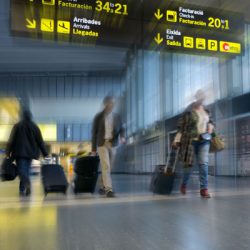IATA welcomes test findings outlining low risk of COVID-19 transmission onboard aircraft
Testing conducted by the United States Transportation Command has supported IATA's report of a low risk of COVID-19 transmission onboard aircraft.
List view / Grid view


‘Seamless travel’ is a term frequently being used to describe the optimum passenger experience, meaning a traveller can complete the entire airport journey without experiencing delays, disruption or confusion.
Self-service technology, predictive analysis, artificial intelligence, real-time information and data-sharing are just some of the digital concepts airports around the world are deploying in an attempt to achieve a seamless passenger experience.
International Airport Review, within this core topic, endeavours to provide case studies on how airports from all corners of the world are working on improving their passengers’ experience. This covers both inside the terminal, and initiatives implemented outside of the terminal that focus on ensuring the passengers’ arrival to the airport is as easy as possible.
This is a key theme in the airport industry that must not be overlooked: As passenger expectations evolve, an airport’s response must do so too.
Testing conducted by the United States Transportation Command has supported IATA's report of a low risk of COVID-19 transmission onboard aircraft.
Oman Airports' efforts to protect passenger health during the COVID-19 pandemic has led Muscat to be the first airport in the region to receive the globally-recognised accreditation.
IDEMIA presents TravelKiosk™, the multi-biometric self-service kiosk for the European Entry/Exit System.
Digital identity as well as touchless biometric technologies help minimise contact at airports.
IATA has outlined that, currently, only 44 cases of COVID-19 have been thought to be associated with a flight journey, representing one case for every 27 million travellers.
Abhi Chacko, Head of Innovation and Commercial IT Services at London Gatwick Airport, discusses how deploying UV treatment of security trays will help restore consumer confidence.
In addition to removing the three destinations from the travel corridors list, the Greek island of Crete has been deemed safe and subsequently added.
To many, airports are seen as a gateway – just part of the process of getting from A to B. However, the amenities they host have the potential to generate income, not just from passengers, but also from those living in the local area. In the wake of COVID-19, do…
For the first half of 2020, worldwide airport passenger numbers decreased by 58.4 per cent when compared to the same period in 2019, with international passenger traffic hit the hardest, recording a 64.5 per cent drop.
While nearly two-fifths of people interviewed said that they would mind if aircraft noise returned to pre-lockdown levels, just under half indicated that they would not.
ACI and IATA have outlined that testing should replace restrictive quarantine measures in order to support the recovery of air travel.
The introduction of the OrderNext mobile ordering platform is part of Teesside International Airport's six-step COVID-19 safety plan for passengers.
Within Issue 5 we gathered expert industry opinions to showcase how accessibility must continue to be a priority for airports.
Qatar's airport has become the first to achieve independent verification from BSI for its implementation of COVID-19 ICAO Aviation Health Safety Protocols.
By adding the new electric buses to transport passengers to its terminals, Charlotte Douglas Airport will see an annual decrease of 50,000 gallons in diesel fuel consumption.